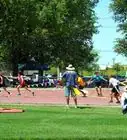This article was co-authored by Kai Ng. Kai Ng is a USATF and RRCA Certified Running Coach at Run Coach Kai. Kai has competed in over 55 races and over 15 marathons, and has trained with 16x USA and World record holder Patti Catalano Dillonso. He specializes in coaching runners of all levels and showing people that everyone can be a runner. Kai is committed to helping his clients reach their goals by showing them how to run with proper form and holding them accountable to train consistently.
There are 18 references cited in this article, which can be found at the bottom of the page.
This article has been viewed 96,643 times.
The half mile (800 meter) run is one of the most difficult yet rewarding races. In the half mile, one must sustain a very fast pace, for a long amount of time. Improving your finish time is a multi step process that involves improving your strength, flexibility, and technique.
Steps
Improving Your Physical Performance
-
1Build endurance. Before you build speed, you need to build the endurance that will let you run the full half mile. Add sprinting into your regular running regimen to start building endurance.
- Start with smaller distances, such as 100-meters, and work your way up. You might also start at 200 or 400 meters, depending on your experience.[1]
- Practice sprinting only after you’ve sufficiently warmed up by jogging or running first.[2]
- Practice sprinting drills to supplement your practice sprints. Try walking on your toes for 20 to 30 meters, followed by walking on your heels for another 20 to 30 meters. Exercises that stretch the legs and develop range of movement are also effective for helping build endurance.[3]
-
2Build muscle mass. Strengthening your core and leg muscles is important in order to keep proper form while running. Strong leg muscles also increase your pushing power when taking off, as well as your overall speed.
- Rather than working your legs at the gym, perform some physical activities that improve your muscles while working other parts of your body as well.
- Tuck jumps are performed by squatting low to the ground, and suddenly jumping into the air as high as you can, while bringing your knees to your chest while airborne.
- Performing skips and focusing on either going as high or as far as possible also builds muscle and cardio strength.[4]
Advertisement -
3Build speed. In order to get a good half mile time, you must have a lot of speed. You should start to incorporate speed workouts into your routine after a couple weeks of simple endurance workouts. There are a few important steps to training for speed.
- Record a baseline. Record your initial speed for a typical run so you can measure your progress. You can record your base speed on a variety of race/track types.
EXPERT TIPTyler Courville is a brand ambassador for Salomon Running. He has run in 10 ultra and mountain races across the United States and Nepal, and won the 2018 Crystal Mountain Marathon.Professional Runner
 Tyler Courville
Tyler Courville
Professional RunnerDon’t be discouraged if building speed is tough. According to Tyler Courville, ultra and mountain runner, “It doesn’t really feel good for anyone when you’re starting. It’s always gonna be a tough process to get going, but you just have to keep at it.”
-
4Practice up hill. Mix a variety of hill runs into your overall training schedule, roughly once or twice a week. Running uphill will build the leg and cardio strength you need to improve your overall speed. Be careful not to injure yourself while running the hills. Relax and don’t push yourself too hard.
- Start simple with simple “green hill” runs. Run only fast enough to work your cardio so that you can hear your breathing. Run easy on the way up the hill, and fast on the way down. Repeat for 10-15 minutes.
- Move on to “red hill” runs when you are feeling ready. This run focuses on building strength – instead of easy on the way up and fast on the way down the hill, you want to run hard up the hill, and regain your strength on the way down. Take care, and repeat for 10-15 minutes.[5]
-
5Run on a track. Look to your local college or high school for available tracks – most are open to the public. Tracks are great for gauging your progress, as they are flat and already measured for distance.
- Stay out of the outermost left lane unless you are running for speed; this is where the faster athletes do their runs.
- For the purposes of training, know that on a standard track, 800 meters is about 2 laps around the track.[6]
-
6Record your times. Write down your times in your running journal. Use this journal to track your progress, and push your speed faster as you feel more comfortable with the run. Frequently review your journal to keep yourself motivated.[7]
- As your performance improves, don't be afraid to update your goals with something more difficult.
- Keep more than just your running times in your journal, such as your heart rate, stretches performed that day, and type of running. This helps track your overall health, as well as the evolution of your training regiment.[8]
-
7Eat healthy. Muscle mass and power are both important for sprinters. A strong diet should cater to these attributes by focusing on carbohydrates and protein. Foods high in these supplements work together to help build muscle.
- During training, focus on getting between 1.2 and 1.5 grams of protein per kilogram of body weight. Similarly, aim for 5 grams of carbohydrates per kilogram of body weight.
- During the day of the race, eat a balance of carbs and proteins three to four hours prior to the race.
- Chicken, turkey, yogurt and baked potatoes are a few examples of food items great for supplementing muscle growth.[9]
Improving Flexibility and Form
-
1Perfect your running posture. Posture and form is just as important to good run times as muscle training. Make sure your form is not inhibiting your run times. Practice good form just as you would any other aspect of training.
- Keep your head still and in line with your spine, while keeping your jaw and neck muscles relaxed.
- Shoulders should also be relaxed.[10] Your shoulders should help guide your upper-body movement.
- Keep arm movements smooth and lock your elbows at a 65 degree angle.
- Record your runs or have a friend observe your technique to understand where your posture may be lacking.[11]
-
2Perform dynamic warmups before training. Dynamic warmups involves moving through a range of motions repeatedly for a set number of repetitions.[12] Unlike static warmups, dynamic stretching more closely resembles the range of motion that can be expected from physical activities.
- Walking high knees work out the gluteal muscles. Perform them by walking in a straight line, while picking up your knees as high as you can during each step.
- ”Toy Soldiers” or “Frankensteins” work out the hamstrings. Perform them by standing straight and holding your arms above your head. Lift one leg out in front of you horizontally, and bring the opposite hand to meet it, touching your toe. Alternate for each side.[13]
- Lower back, hamstrings, quadriceps, calves, Achilles, and rotator cuffs are all important areas to focus on when building flexibility for sprinting.
-
3Perform static stretching (optional). Static stretching lengthens muscles through holding a particular stretch in one position over a period of time. Static stretching is best suited for cooling down periods, as they don’t work the same range of motion as dynamic stretching, and may inhibit sprinting performance.[14]
- ”The Hamstring Stretch” does just that – slowly stretches the hamstring muscles in your leg. Place one leg on a low stool with your hips and feet facing forward. Lean forward from your hips while keeping your back flat and knee straight, until you feel a stretch in the back of the thigh.
- ”The Quadriceps Stretch” stretches the quad muscles in your leg. Simply bend your leg at the knee toward the back of your thigh and grab your ankle. Keep your back straight and your bent knee in line with your hip. Gently pull your ankle toward your buttocks until you feel a stretch in the front of your thigh.[15]
Executing the Half Mile Race
-
1Do a practice 800-meter run. Get out on a track and perform as though you were actually running the race. You want to put the training you’ve been doing into real world practice. Make all the preparations you would as though it were the actual day of the race.
- Bring a friend along to observe your performance. They can give you a heads up on where you slowed down, where you did well, and how your posture looked.
- Make sure you time your efforts using a stop watch and record them in your journal.
- Practice 3 to 4 weeks before the actual day of the race to give you a good idea of how you can expect to perform on race day.[16]
-
2Review your start. The start of the race can have an impact on how you end up finishing the race. You want to get yourself into a comfortable pace within the first 20 to 30 meters of the race. Be aggressive to reach that pace as soon as possible.[17]
- Try to reach the middle of the racing pack from the start to avoid getting caught up in the slower runners.
- Push hard early to take advantage of your lactic energy system. This energy system provides between 7 and 8 seconds of energy at the start of a race, and if you don't push hard within that time, that energy is lost.[18]
-
3Create goals for each lap. Break down your overall goal of running a faster 800-meter race into smaller pieces. This makes practicing and training easier to process.
- Check your times at the 200 and 400-meter marks. Your 200-meter timing should be a few seconds faster than the 400-meter timing.
- Successful 800-meter runs involve running the first 400 meters at around 90 to 93 percent of your best 400 time.
-
4Stick with it. In the first few races you participate in, you will probably not get the time that you are really capable of. Keep working hard and set personal goals for yourself. A good mindset and visualization will help lower your times.[19]
- Be social. Talk to the other runners and compare goals, experiences, and disappointments. By making friends, you will find people who will push you to do your best.
- Keep your goals reasonable. If your current goal seems too difficult to achieve, focus on getting halfway there. This keeps your goals achievable and gives you a sense of progression that you might have lacked before.[20]
Expert Q&A
-
QuestionWhat should you do to enhance endurance?
 Kai NgKai Ng is a USATF and RRCA Certified Running Coach at Run Coach Kai. Kai has competed in over 55 races and over 15 marathons, and has trained with 16x USA and World record holder Patti Catalano Dillonso. He specializes in coaching runners of all levels and showing people that everyone can be a runner. Kai is committed to helping his clients reach their goals by showing them how to run with proper form and holding them accountable to train consistently.
Kai NgKai Ng is a USATF and RRCA Certified Running Coach at Run Coach Kai. Kai has competed in over 55 races and over 15 marathons, and has trained with 16x USA and World record holder Patti Catalano Dillonso. He specializes in coaching runners of all levels and showing people that everyone can be a runner. Kai is committed to helping his clients reach their goals by showing them how to run with proper form and holding them accountable to train consistently.
Certified Running Coach If you want to enhance your endurance, you should run effortlessly. Increase the time and distance you run consistently. For example, increase your running time from 10 minutes to 15 minutes, then 20 minutes. It will enable your body to burn fat rather than carbs for fuel. Encourage it to make more red blood cells and have more oxygen in the bloodstream that goes to the muscles.
If you want to enhance your endurance, you should run effortlessly. Increase the time and distance you run consistently. For example, increase your running time from 10 minutes to 15 minutes, then 20 minutes. It will enable your body to burn fat rather than carbs for fuel. Encourage it to make more red blood cells and have more oxygen in the bloodstream that goes to the muscles. -
QuestionHow do I win the half mile?
 Community AnswerYou don't really have control over the other participants, so you can't guarantee a win, but try your hardest and stay physically fit for a better chance at winning.
Community AnswerYou don't really have control over the other participants, so you can't guarantee a win, but try your hardest and stay physically fit for a better chance at winning. -
QuestionHow do I turn on the adrenaline to get through the end of the race?
 WikiHowUser20170531145154Community AnswerSometimes you just have to push it. If you can see the finish or know it's just around the bend then you just need to run as hard as you can. Remember, you can stop once you cross the finish, so push it as hard as you can in the last 100 meters or so. You have to be excited and want to win.
WikiHowUser20170531145154Community AnswerSometimes you just have to push it. If you can see the finish or know it's just around the bend then you just need to run as hard as you can. Remember, you can stop once you cross the finish, so push it as hard as you can in the last 100 meters or so. You have to be excited and want to win.
Warnings
- Before the race, make sure that you drink plenty of liquids to avoid dehydration.⧼thumbs_response⧽
References
- ↑ Kai Ng. Certified Running Coach. Expert Interview. 12 February 2021.
- ↑ http://www.halfmarathons.net/half-marathon-training-schedule-for-beginning-runners/
- ↑ http://www.brianmac.co.uk/sprints/sprintdrills.htm
- ↑ http://www.bodybuilding.com/fun/tomgreen1.htm
- ↑ http://www.runnersworld.com/ask-coach-jenny/how-to-learn-to-love-running-hills
- ↑ http://www.runnersworld.com/run-faster/track-running-dos-and-donts
- ↑ http://www.runnersworld.com/run-faster/overview-how-to-run-faster
- ↑ http://www.best-running-tips.com/running-journal.html
- ↑ http://www.stack.com/a/sprinter-diet
- ↑ Kai Ng. Certified Running Coach. Expert Interview. 12 February 2021.
- ↑ http://www.stack.com/a/sprint-form-checklist
- ↑ Kai Ng. Certified Running Coach. Expert Interview. 12 February 2021.
- ↑ http://breakingmuscle.com/mobility-recovery/dynamic-stretching-does-it-help-or-harm-before-sprinting
- ↑ http://www.ncbi.nlm.nih.gov/pubmed/20683355
- ↑ https://www.hss.edu/conditions_stretching-tips-athletes-dynamic-static.asp
- ↑ http://www.runnersworld.com/race-training/run-rehearsal-races-to-nail-your-next-goal
- ↑ http://trackstarusa.com/how-to-run-the-800m/
- ↑ https://www.coachup.com/resources/running/race-strategy-for-distance-runners
- ↑ https://www.psychologytoday.com/blog/flourish/200912/seeing-is-believing-the-power-visualization
- ↑ http://www.active.com/running/articles/4-tips-to-stay-motivated-on-your-long-run








































































